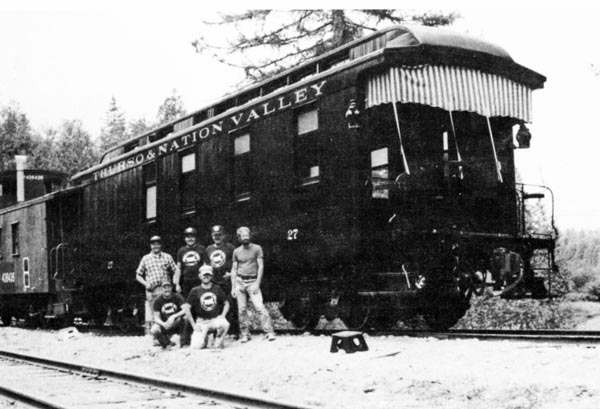|
Thurso Railway Remains
On June 14, 1992, a small
group visited the area of the former Thurso Railway, which was closed
six years ago, to see what was left of the line. The trip was organized
by Bob Meldrum while Joe Toscas obtained permission for the group to
enter on to company property to explore the former right of way, which
ran 57 miles roughly north from Thurso, Quebec. Leaving Thurso, we
drove north through Ripon and Cheneville to Duhamel. The course of the
southern part of the route is clearly visible and we could easily make
out the several grade crossings on highway 317.
Duhamel was the headquarters of the logging operation in the 1940s and 1950s and the course of the line through the small community can easily be traced. Ditches have been dug by residents to discourage joy riders. A couple of loading ramps can be made out but the most substantive relic is the former engine house which was built to house the GE diesels that worked in the woods. This is now used by the municipal fire department and is in good condition. Looking through the door window we could see one set of rails set in the concrete. It is an interesting comment that a building had to be built for the diesels while the Heisler they replaced was kept outside all the time. Between Duhamel and Singer the right of way is used as a one way logging road and we took this past the shore of Lac de la Ferme. The location of the wye at Lac de la Ferme can still be traced and we found the remains of the Thurso combine car which was abandoned here many years ago. This would appear to be of 1890 vintage and presumably of CP origin. The roof has fallen in and one end platform has succumbed to the undergrowth. We continued on to the bottom of "mile hill" but the road bed was flooded and we decided to turn back. This is the area which suffered from the attention of beavers and there was a notice to enginemen which said "BEWARE OF BEAVERS". A short detour took us on a logging road to a former crossing with the railway at the steepest part of the climb to Iroquois. Our sharp eyed sleuths then found the remains of a four wheeled ballast dump car that is buried in the fill. There was a large washout in this area one time and the tracks were suspended in ] mid air. The small cars or buggies were being used to fill the hole. The change of grade at the top of the hill, together with the short length of these cars, were enough to uncouple them and three of them ran away. The first two made it across the washout but the third one went in. The work crew found it easier to dump right on top of it. The luckless work car now does double duty as an unconventional culvert.  The rest of the right of way to Singer is in relatively good condition although it is not for low hung vehicles. We stopped for a time at the location of the siding at Iroquois and reflected on its former glories. There were still to be seen parts of the platform erected by the Thurso gang for when Car 27 would spend the weekend. The former junction with the short branch to Iroquoij can be easily ascertained now that the log loading has been discontinued in this area. We continued along through the deep dank cut that marked the summit of the line, past the scenic lakes and quickly arrived at Singer. At Singer are the CP boxcar and the cab of the Barnhartlog loader which are still used as storage huts. The speeder shed is also still there but the train order signal had gone. The area of the Singer wye is fenced off and there is not a great deal to see. The tail track, which was formerly the beginning of the 12 mile branch to Savanne, has been cut by the collapse of the small bridge over a stream. The Savanne Branch had 9 per cent grades! The west leg of the wye revealed cinder ballast mixed with small pieces of locomotive coal which must have been there for at least 40 years. South of Singer the right of way has
been sold to adjacent land owners and access is occasionally difficult
It is possible to see from the road a mile or so south of Singer the
turntable which was used for many years as a bridge. This is still in
good condition although some of the timbers are getting a little soft.
On our way back to Thurso we stopped in at the site of the "station" at Ripon. This speeder shed, on private property, is close to the Montpelier road and is in quite good condition. Our last stop was to visit the last remains of a Barnhart log loader cab which had been used as a shim shack but which seems to have fallen apart several years ago. It was an interesting day which served to rekindle old memories of an interesting railway which had a unique way of railroading. Many of the relics are difficult to find and nature will soon cover up most of the traces of this logging railway. Many thanks to Bob and Joe for organizing this excellent day. Bytown Railway Society, Branchline, September 1992. |